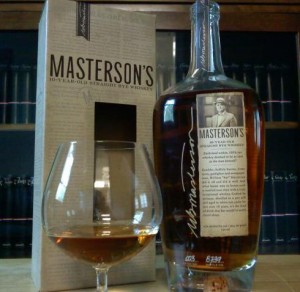The Rye Whiskey Craze and Crunch
By Richard Thomas
Whiskey of all types has experienced a boom in sales in recent years, and while shortage stories periodically pop up in the media, these vague ruminations are largely unfounded. Unfounded, that is, unless you are talking about rye whiskey.
That a rye whiskey craze and crunch is in progress is beyond dispute. Sales of rye whiskey have gone up every year for the last several years, with the Distilled Spirits Council of the United States 2011 Industry Report indicating more than a 50% increase for that year alone. The massive demand has caused the big distillers to add new rye expressions, and induced numerous micro-distilleries and whiskey-makers to do the same, including some who started up specifically to cash in on the rye boom.
The peculiar thing about the rye craze is that, unlike the growth experienced by other types of whiskey, for the most part it is not driven by a rapid expansion in the ranks of rye lovers. Most of the people drinking up record amounts of rye whiskey aren’t sipping on neat rye or rye on the rocks, nor do they seem to love rye whiskey for its own sake. Instead, they value rye for its prominent place in the ongoing and parallel boom in upscale cocktails, or mixology.
A Rye Manhattan, Please
For whiskey-based cocktails, rye has become the whiskey of choice in America, prized as a foundation liquor for its particular qualities. “Rye has a uniquely dry body and a spice to it that isn’t commonly found in traditional bourbons” says Zachary Sharaga of New York bar Louis 649. “Rye provides whiskey-based cocktails with a dry foundation onto which a wider range of flavors can be incorporated.”
That sentiment shared by most upscale bartenders. For decades, Manhattans were often made using bourbon instead of rye, as the most widely available American-made whiskey. The start of the mixology trend changed all that. “In a cocktail like a Manhattan,” says Paul Martin of The Monkey’s Paw in Chicago, “bourbon can be too sweet when mixed with the sweet vermouth. Rye offers an option for a more balanced cocktail, and the spice just adds another layer of complexity.”
And the mixology boom’s thirst for rye extends far beyond the much-talked about Manhattan. A wide variety of cocktails, such as the Old Fashioned and the Great Pumpkin, also call for rye. The Sazerac is so intertwined with rye that it has an entire line of rye whiskeys named for it, running right up to limited edition 18 Year Olds.
The Supply Crunch
What drives the supply crunch for rye, insofar as the mixology trend is concerned, is that trend’s focus on premium whiskey for upscale cocktails. The bartender at your local trendy nightspot isn’t making cocktails with Old Overholt alone, although Old Overholt is still widely used, and Whiskey Reviewer readers report that sometimes even that old standard is absent on store shelves. Louis 649 uses Overholt and Rittenhouse, while The Monkey’s Paw prefers High West, Rendezvous Rye and FEW Spirits. 35 Maple Street’s Masterson’s 10 Year Old is another popular choice with many bars around the country, while the new Knob Creek Rye enjoys a growing popularity.
Imagine the distillery ships 4,000 cases a year of your favorite rye (a not unrealistic number for a micro-distillery), and the upscale bar in your neighborhood also loves that rye for its cocktails. Now imagine that bar goes through 150 cases of your favorite rye a year, and then assume there are a dozen other bars just like it across North America. That baker’s dozen of cocktail bars consume half the production of your favorite micro-distillery, which might explain why your preferred rye isn’t on the shelf much of the time.
The rye crunch hits the very mixology joints that contribute so much to it as well. Shagara describes shortages as “pretty standard,” and while Martin hasn’t run out of his choice ryes yet, he reports that “High West 16 Year and Rendezvous Rye are about to dry up in Illinois.”

keeping up with demand
(Credit: S.D. Peters)
Meeting the Demand
Despite the numerous new entries into the market and the ramping up of production, the prospects for the rye supply catching up with demand remain decidedly mixed for the near future. Jim Beam, the biggest rye producer and maker of both Old Overholt and Knob Creek Rye, strikes a decidedly optimistic tone on this issue, saying they expect demand for their new rye to continue to grow, and that they are “fully prepared to meet that demand,” but they are almost alone in that sentiment.
Other distilleries are less certain of their ability to catch up or stay on top of the craze for the near future. Jim Knapp at 35 Maple Street describes the demand for Masterson’s 10 Year Old as “outpacing our supply.” Brian McKenzie of Finger Lakes, a micro-distillery in upstate New York, points to their rye as “the fastest growing product in our portfolio,” and stresses the need for their distillery to strike a careful balance between production and distribution, so as to avoid supply problems. At the time of publication, Finger Lakes Rye was available only in the states of New York, New Jersey and Illinois.
Crossover?
A question on the lips of many whiskey-lovers is if any of the cocktail-loving sophisticates might want to come join them on the porch for two fingers of rye, and the crossover picture looks very good indeed. “Straight rye whiskey drinkers love ordering our cask-aged old fashioned” says Paul Martin of The Monkey’s Paw, “because they appreciate the effect wood can have on the final product,” and believes that spurs an interest in rye for its own sake.
Zachary Shagara of Louis 649 thinks many of the upscale cocktail drinkers were already whiskey fans in the first place, indicating that “a person usually interested in rye cocktails usually has an established foundation of being a straight whiskey drinker who has forayed beyond the de rigueur American drinking habits of bourbon consumption into rye consumption.”
The distillers and whiskey-makers concur that there is substantial overlap between the whiskey-lover and the cocktail drinker. “I know some whiskey connoisseurs wouldn’t ever consider diluting their dram with water or ice, let alone other cocktail ingredients, but I think some are willing to experiment,” says Brian McKenzie. “Much like how serious Scotch drinkers have gradually discovered the merits (and value) in bourbon, I think rye is just another extension of whiskey drinkers looking for new tastes and flavor profiles.”
The Future

(Credit: S.D. Peters)
While the idea of a strong crossover culture for rye still suggests that the rye boom might plateau at some point, the renewed strength of rye’s presence in the whiskey world is here to stay. Furthermore, few regard the mixology trend that has driven so much of the growth in rye as a mere fad. “The upscale cocktail scene is here to stay, much like the craft beer scene” says Paul Martin.
Besides, the upscale cocktail picture has moved beyond trendy night spots and into posh restaurants. Brian McKenzie at Finger Lakes reports that his whiskey is the official foundation of Rye Manhattans for “the entire Jean Georges group of restaurants in New York City.” Rye is even finding its way from the restaurant bar and into the kitchen. Knob Creek Rye was observed in use by chefs at this year’s Aspen Food & Wine Classic.
If anything, the growth in rye whiskey might continue to accelerate. How much longer until hipsters from Williamsburg to Portland decide en masse to push aside their PBRs and reach for a tumbler of trendy-but-obscure rye whiskey? If you thought your favorite rye was hard to get before, just you wait.



I’m not sure I’d agree the “craze” is here to stay. My hope is that it will introduce just enough whiskey drinkers to cross over to neat Rye, to ensure there’s a reasonable demand after the bandwagoners jump off for whatever craze is next. For those of us who were neat Rye drinkers before the craze, Jim Beam’s confidence is palliative enough for now. We spent those lean years relying on Beam’s average Ryes, & can revert back to them in a pinch, while we wait out the craze.
Arch-hack Chuck Cowdery has spent the last couple of years telling anyone who would listen (including myself, unfortunately) that there was no rye whiskey boom. Well, the numbers multiplied year after year and now something like Old Overholt ships as much stuff as Woodford, and there are a bunch of new labels out there. Does that guy EVER get tired of being wrong?
Seeing this for the first time as the Sunday Oldie, I want to respond to this comment.
I was a regular reader of Chuck’s blog until last year, when he went nutso about KDA’s tours and such. Knowing that he did tours himself, it smacked of MAJOR conflict of interest. That put a really bad taste in my mouth, and I have been back only a few times since.
So I went and looked about his record on rye, and you are right. He was ABSOLUTELY wrong.